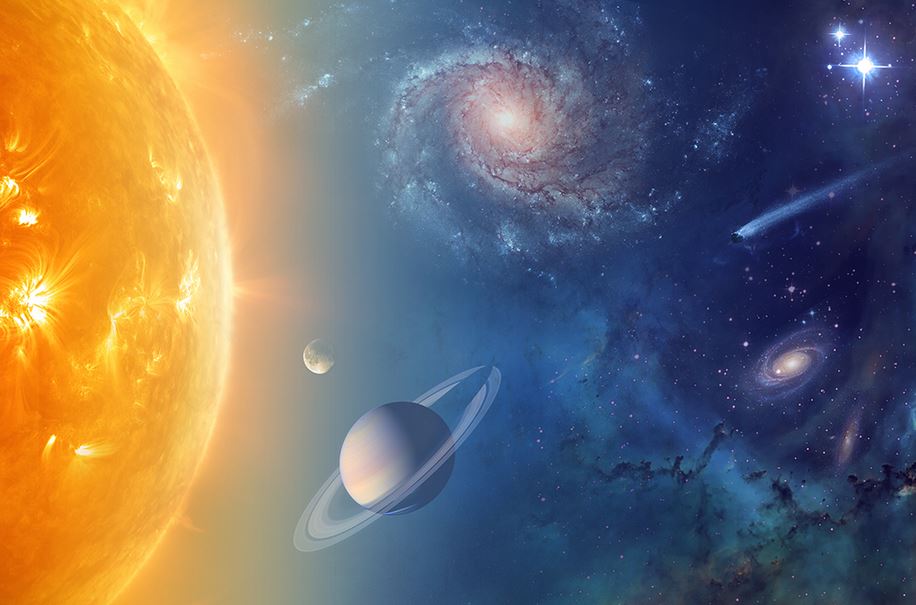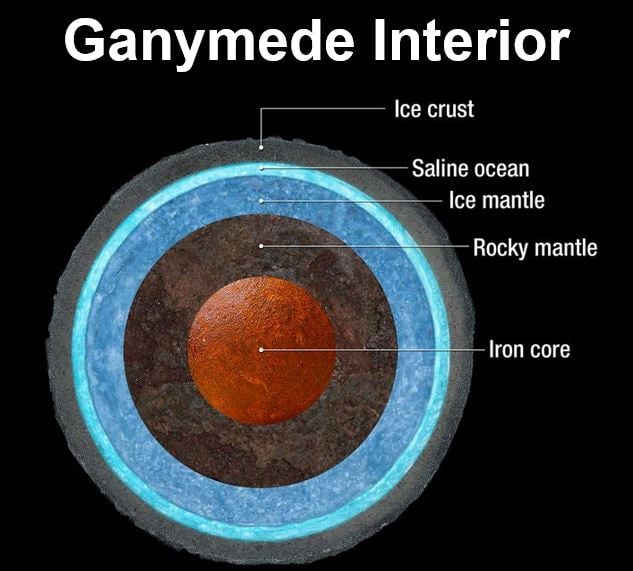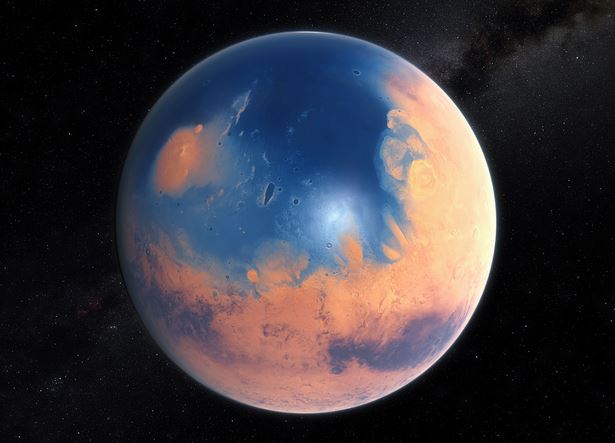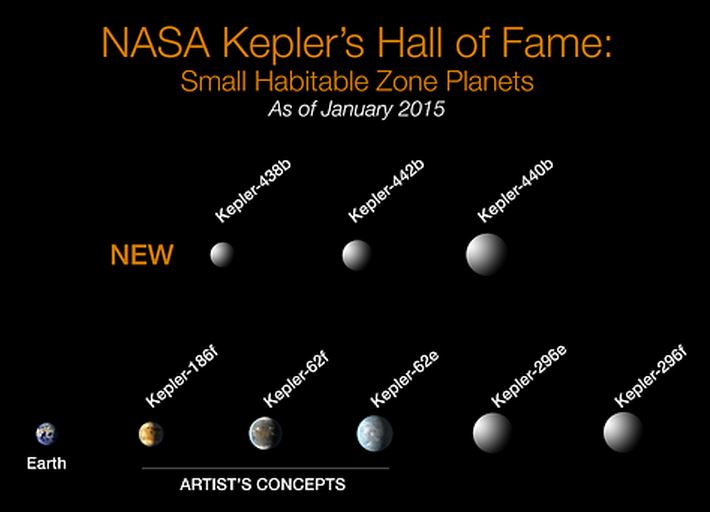NASA’s chief scientist, Ellen Stofan, says it is no longer a question of whether we will ever find alien life, but when. As NASA missions search through our solar system and others for new worlds, they are discovering water, a major ingredient for life as we know it, in the most surprising places, she explained.
While water is only one piece in our search for habitable planets and life beyond Earth, it links many apparently unrelated worlds in surprising ways.
Dr. Stofan said:
“NASA science activities have provided a wave of amazing findings related to water in recent years that inspire us to continue investigating our origins and the fascinating possibilities for other worlds, and life, in the universe.”
“In our lifetime, we may very well finally answer whether we are alone in the solar system and beyond.”

NASA is exploring our solar system and other planetary systems to understand the workings of the Universe, searching for water and life among the stars. (Image Credit: NASA)
Dr. Stofan, who was speaking at a conference in Washington, said she believed we will find alien life out there in space by 2025. She warned people about becoming over-excited regarding this prospect, adding that “We are not talking about little green men. We are talking about little microbes.”
Jeffery Newmark, interim director of heliophysics at Nasa, added “It’s definitely not an if, it’s a when.”
Universe is full of hydrogen and water
Water is made up of two elements, oxygen and hydrogen, which are some of the most abundant elements in the Universe.
Scientists today see the signature of water in huge molecular clouds between the stars, in disks of material that represent nascent planetary systems, and in the atmospheres of large planets orbiting distant stars.
NASA researchers believe several worlds possess liquid water beneath their surfaces, while others have water in the form of vapor or ice.
Water in many planets and other celestial bodies
Water exists in primitive celestial bodies like asteroids and comets, as well as in dwarf planets like Ceres. Water is believed to be present in the atmospheres and interiors of Jupiter, Neptune, Uranus and Saturn, and their rings and moons probably have substantial water ice.
Four icy moons – Ganymede, Europe and Callisto at Jupiter, plus Titan and Enceladus at Saturn – show strong evidence of oceans underneath their surfaces.
The Hubble Space Telescope recently provided compelling evidence that Ganymede has a saltwater ocean beneath its surface, probably sandwiched between two thick layers of ice.

An artist’s depiction of the interior of Ganymede. The cake-layering of the moon shows that ice and a saline ocean dominate the outer layers. A denser rock mantle lies deeper within the moon, plus an iron core beneath that. (Image Credit: hubblesite.org)
Enceladus and Europa are believed to have a liquid water ocean beneath their surface in contact with mineral-rich rock. It appears they have three ingredients essential for life as we know it: sources of energy that could be used by living things, essential elements for biological processes, and liquid water.
Data from NASA’s Cassini mission showed that Enceladus has an abundance of icy geysers. Recent studies suggest it might have hydrothermal activity on its ocean floor, which has the potential for creating an environment where living organisms could thrive.
The permanently shadowed craters on Mercury appear to have water, NASA spacecraft have revealed. Even our own Moon probably has much more water than we had thought.
While some parts of our solar system may seem soaked, others appear to have lost huge amounts of water.
Mars had abundant water and lost much of it
NASA spacecraft have found clear evidence that Mars had water on its surface a long time ago for long periods. The Curiosity rover found an ancient streambed that existed within conditions that could have hosted life as we know it.
NASA’s ground-based telescopes have provided data which scientists have used to estimate how much water Mars lost over billions of years.
They concluded that the Red Planet once had enough water for an ocean that would have covered nearly half its northern hemisphere, with depths reaching about 1.6 kilometers (1 mile). So, what happened to all that water?

An artist’s impression of how Mars might have looked approx. 4bn years ago. (Image Credit: ESO)
Scientists believe that some of it is below the surface and in the Martian polar ice caps. NASA also thinks that a great deal of Mars’ early atmosphere was stripped away by the wind of charged particles coming from the Sun, which dried out the planet. NASA’s MAVEN mission is currently working on this lead as it orbits Mars.
Understanding water distribution in our solar system
NASA wrote:
“Understanding the distribution of water in our solar system tells us a great deal about how the planets, moons, comets and other bodies formed 4.5 billion years ago from the disk of gas and dust that surrounded our sun.”
“The space closer to the sun was hotter and drier than the space farther from the sun, which was cold enough for water to condense.”
“The dividing line, called the “frost line,” sat around Jupiter’s present-day orbit. Even today, this is the approximate distance from the sun at which the ice on most comets begins to melt and become “active.” Their brilliant spray releases water ice, vapor, dust and other chemicals, which are thought to form the bedrock of most worlds of the frigid outer solar system.”
Scientists say that during the solar system’s early days, it was too hot for water to condense into liquid or ice on the inner planets, so it was probably delivered by comets and asteroids.
NASA’s Dawn mission is currently studying Ceres, the largest object in the asteroid belt between Jupiter and Mars. Scientists believe Ceres may have a water-rich composition not that different to some of the bodies that transported water to the three rocky, inner planets, including ours (Earth).
The amount of water in Jupiter holds a vital missing piece of the puzzle regarding the formation of our solar system. Jupiter was probably the first planet to form, and it contains most of the material that was not incorporated into the Sun.
The leading theories regarding Jupiter’s formation rest on how much water it soaked up. To help find the answer to this mystery, NASA’s Juno mission will be measuring the planet’s water content in the middle of next year.
Other planetary systems
Observing planetary systems beyond our own allows us to glimpse at our solar system’s early years, where water played a key role.
NASA’s Spitzer Space Telescope has observed signs of a hail of water-rich comets raining down on a solar system much younger than ours. What we see there is what occurred in our own solar system when it was much younger.
We are much closer now to determining how many exoplanets – planets outside our solar system – have the ingredients for life, including water, like ours. Planets that could have the ingredients for life are said to be in the goldilocks zone – the right distance from their stars so that conditions could be ‘just right’.

In January, NASA announced that its Kepler Space Telescope had found eight new planets orbiting their suns in the goldilocks (habitable) zone. (Image credit: NASA)
NASA wrote:
“In fact, our basic concept of what makes planets suitable for life is closely tied to water: Every star has a habitable zone, or a range of distances around it in which temperatures are neither too hot nor too cold for liquid water to exist.”
“NASA’s planet-hunting Kepler mission was designed with this in mind. Kepler looks for planets in the habitable zone around many types of stars.”
“Recently verifying its thousandth exoplanet, Kepler data confirm that the most common planet sizes are worlds just slightly larger than Earth. Astronomers think many of those worlds could be entirely covered by deep oceans. Kepler’s successor, K2, continues to watch for dips in starlight to uncover new worlds.”
NASA’s TESS Mission, which will be launched soon, will seek out Earth- and super-Earth-sized exoplanets near bright stars beyond our solar system.
Some of the exoplanets TESS discovers are bound to have water, and NASA’s next great space observatory, the James Webb Space Telescope, will study the atmospheres of those fascinating worlds in great detail.
We often forget that the story of our own planet’s water, from gentle rains to raging rivers, is very closely linked to the larger story of our solar system and beyond.
NASA wrote:
“But our water came from somewhere — every world in our solar system got its water from the same shared source.”
“So it’s worth considering that the next glass of water you drink could easily have been part of a comet, or an ocean moon, or a long-vanished sea on the surface of Mars. And note that the night sky may be full of exoplanets formed by similar processes to our home world, where gentle waves wash against the shores of alien seas.”
NASA Video – Water in the Universe
This panel discussion from NASA headquarters talks about recent discoveries of water and organics in our solar system, the role our sun plays in water-loss in neighboring planets, and our search for habitable worlds among the stars.

